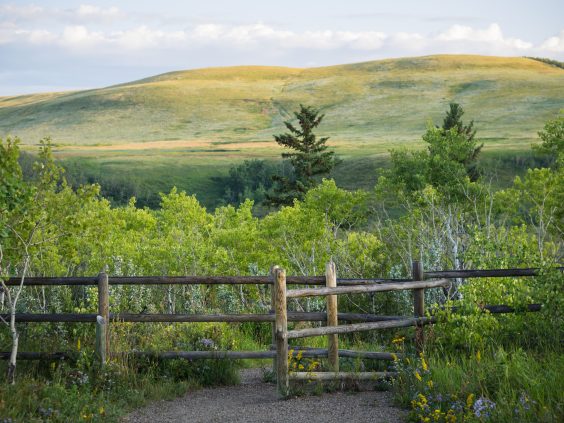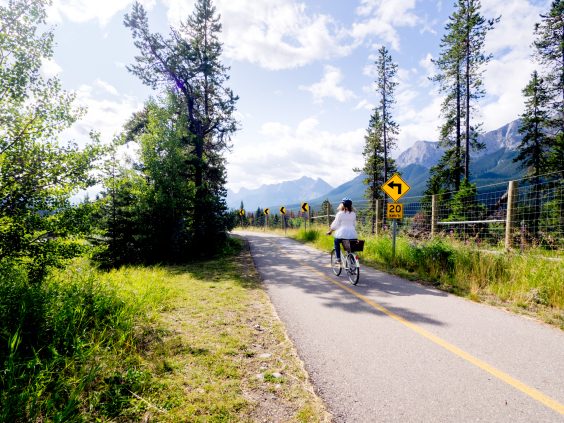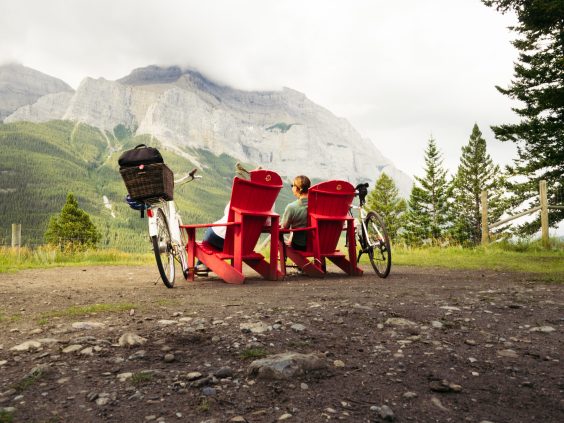By Kim Gray
Not long ago, from our home base in Calgary and in the space of one ambitious day, photographer Lori Andrews and I explored three different sections of The Great Trail of Canada — the 27,000 kilometre network of multi-use trails that links our country from coast to coast to coast.
We started at sunrise with a glorious ramble through Glenbow Ranch Provincial Park, just 30 minutes by car northwest of the city.
A few hours later, we hit the road to nearby Canmore where we jumped on our bikes for a spin along the popular Legacy Trail that runs between this charming mountain town and Banff.
And then we wrapped up the day with a gentle hike in Kananaskis Country’s beautiful West Bragg Creek.
Given our experience — and that the collective health of Canadians has never been more important — I’ve gathered together five reasons why you, too, stand to benefit from stepping out on The Great Trail in your backyard.

Glenbow Ranch Provincial Park, Calgary, AB / Photo by Lori Andrews @theoriginal10cent on IG
1. You will feel better
If the current state of the planet has done one thing, it’s highlighted humanity’s dependence on a healthy ecosystem for survival. It’s also made it abundantly clear that we are, indeed, part of nature’s fabric ourselves.
Have you ever regretted going for a walk in the woods? Not likely. Being in the outdoors, it turns out, is the most natural thing in the world for us.
Science has consistently shown that spending time in nature helps us cope more easily with life’s challenges, improves our physical health and generally makes us higher functioning, happier humans.
You can’t argue with the well-being that comes from discovering a new trail where, during an early morning trek through a sun-dappled forest, you decompress with a friend, spot a striking young buck staring you down from a distant field and literally take time to smell the wildflowers along the way.
“Nature knows what you need,” someone declared to me recently. I couldn’t agree more.

Glenbow Ranch Provincial Park, Calgary, AB / Photo by Lori Andrews @theoriginal10cent on IG
2. You may learn something new
Since March, travel restrictions have forced Canadians to double down in their immediate communities.
But these limitations, as difficult as they are, have an upside. We’re seeing our neighbourhoods with fresh eyes and strengthening our sense of place in a landscape we thought we already knew.
Laval St. Germain, a champion of The Great Trail, only recently discovered Glenbow Ranch Provincial Park and its user-friendly series of trails.
“When I first drove into the park, with the sun painting the grasslands in golden light, I found myself uttering expletives about the beauty of the place, and at the fact that I had somehow overlooked it,” says St. Germain, a Calgary-based adventurer and pilot.
“My wife, Janet, rode the paved paths and I ran the trails. We passed deer, saw hawks, flushed partridge, heard coyotes and got a great workout as the terrain undulated along the north bank of the river below.”
These days, I take comfort knowing that this historic park is on standby for future adventures. What jewel of a trail, I wonder, is waiting around the bend for you?

The Legacy Trail, Canmore, AB / Photo by Lori Andrews @theoriginal10cent on IG
3. You’ll boost your fitness
If there’s anything The Great Trail represents beyond connecting communities countrywide, it’s active living.
Alberta’s Legacy Trail, for example, is a magnet for sports lovers year round. According to Canadian World Cup champion skier and Olympian Ken Read, the trail is a “core staple” for the local cycling community.
“We’re out there weekly right now,” Read, another trail champion, tells us. “We start in Canmore and end up at Banff’s White Bark Café, a popular hangout for cyclists.”
That said, Read sees a wide range of people cycling on the trail, “all shapes and sizes, across every age from kids to grandparents — people who wouldn’t be there if the trail didn’t exist. I love seeing this because recreation is key to better fitness in general.”
Lori Andrews (the talent behind this story’s photos and, as mentioned earlier, my travel buddy on this assignment) is also an enthusiastic cyclist. She enjoys reminding people that beyond exercise, biking is inherently a fun thing to do.
“Think about it. It’s the closest thing you can do to flying. Your feet never touch the ground and you’ve got the wind blowing through your hair,” says Andrews, adding with a laugh: “I mean, if you don’t ride a bike, are you even living?”
I’ve been riding more than ever these days. It makes me feel like a kid again.

The Legacy Trail, Canmore, AB / Photo by Lori Andrews @theoriginal10cent on IG
4. You can socialize safely
During the pandemic, Canadians are being encouraged to gather outside if they choose to spend time with anyone who isn’t in their bubble.
I’ve been doing this all summer — hiking with extended family, a few members at a time, in the mountains, gathering several feet apart with a handful of close friends around a backyard bonfire and social distance walking along the Bow River Pathway in Calgary.
Social isolation can take a toll on people. We need each other and we need to find safe ways to enjoy a semi-normal existence in a not-so-normal time.
Why not research The Great Trail (following the guidelines in place for use during the pandemic) and employ it as a means to socialize in ways you haven’t otherwise considered?
In the spring, summer and fall, there’s walking, hiking, biking, rollerblading and even paddling to be had (given that waterways are included in this lofty network of trails.) Winter brings other opportunities like cross-country skiing, fat biking, snowshoeing and skating.
I’ve cycled Alberta’s spectacular Legacy Trail a few times recently, enjoying the company of friends and family at a safe distance.
An unexpected bonus? The camaraderie and warm exchanges I experienced with other trail users along the way.

West Bragg Creek, AB / Photo by Lori Andrews @theoriginal10cent on IG
5. You may see something beautiful
Late Irish poet John O’Donohue wrote that when human beings are confronted with beauty “there’s a sense of homecoming. Beauty meets the needs of the soul and we get a break from the ‘strains and struggles’ of our regular existence.”
With this in mind, we were interested to learn from Alf Skrastins — a volunteer with The Greater Bragg Creek Trails Association (which oversees the West Bragg Creek section of The Great Trail) — that natural beauty is a key consideration when building trails in the first place.
“It’s as critical to trail building as proper drainage and tread durability,” he says. “Imagine, if we stuck to the hillside and stayed in a pine forest, the trail would very quickly become boring.” Good trail builders, he says, are attuned to aesthetics, the rise and fall of terrain and how vegetation plays differently depending on the season.
Skrastins says he especially enjoys hiking in West Bragg Creek during the golden hour, when the day is turning to dusk.
“There’s nothing like the late day light filtering through the trees. You can go through a spruce forest, which is dark and mysterious, and pop out into a grove of aspens and it’s bright, with yellow filtered light coming through the leaves. The next moment, you can be in a stand of pines, vertical pole-like trees, with shadows and shafts of light pouring through.”
We had serious stop-in-your-tracks “beauty” moments throughout our day on The Great Trail.
We soaked up sweeping vistas of grasslands at Glenbow Ranch Provincial Park. We cycled in the shadow of Rocky Mountain giants along The Legacy Trail. And we feasted our eyes on lush pockets of forest as we explored Kananaskis Country’s West Bragg Creek.
It turns out, most Canadians live within 30 minutes of this phenomenal resource connecting people from coast to coast to coast — one more reason, if you ask us, to find a trail and follow your bliss.
This post was powered by The Great Trail
As always, Toque & Canoe is grateful to our partners in travel throughout Canada who help keep us paddling forward.
Founded by two Canucks on the loose in a big country, Toque & Canoe is an award-winning Canadian travel blog. Follow us on Twitter, Instagram and Facebook

